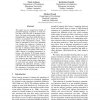Free Online Productivity Tools
i2Speak
i2Symbol
i2OCR
iTex2Img
iWeb2Print
iWeb2Shot
i2Type
iPdf2Split
iPdf2Merge
i2Bopomofo
i2Arabic
i2Style
i2Image
i2PDF
iLatex2Rtf
Sci2ools
ACL
2012
2012
Exploiting Social Information in Grounded Language Learning via Grammatical Reduction
This paper uses an unsupervised model of grounded language acquisition to study the role that social cues play in language acquisition. The input to the model consists of (orthographically transcribed) child-directed utterances accompanied by the set of objects present in the non-linguistic context. Each object is annotated by social cues, indicating e.g., whether the caregiver is looking at or touching the object. We show how to model the task of inferring which objects are being talked about (and which words refer to which objects) as standard grammatical inference, and describe PCFG-based unigram models and adaptor grammar-based collocation models for the task. Exploiting social cues improves the performance of all models. Our models learn the relative importance of each social cue jointly with word-object mappings and collocation structure, consistent with the idea that children could discover the importance of particular social information sources during word learning.
| Added | 29 Sep 2012 |
| Updated | 29 Sep 2012 |
| Type | Journal |
| Year | 2012 |
| Where | ACL |
| Authors | Mark Johnson, Katherine Demuth, Michael C. Frank |
Comments (0)

